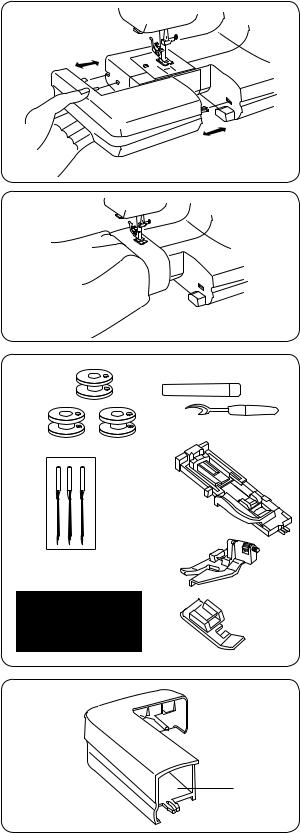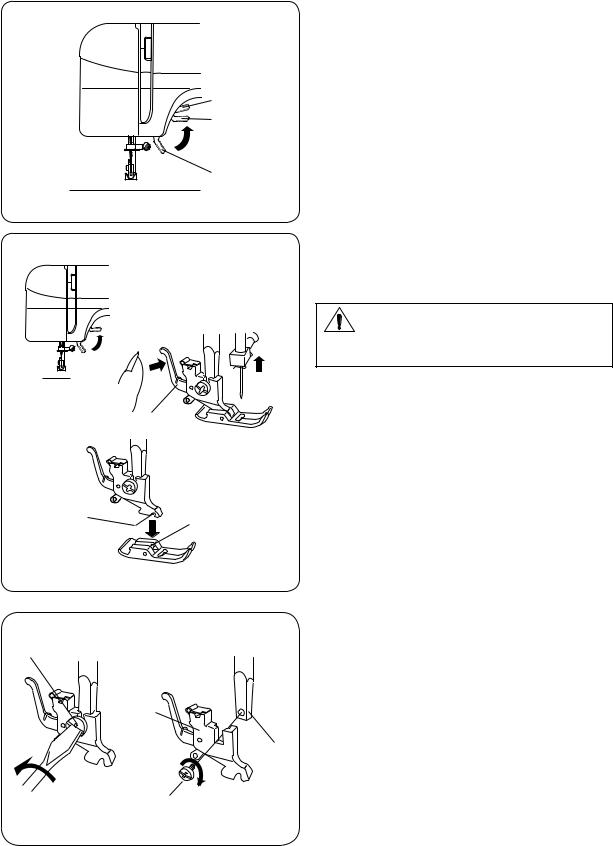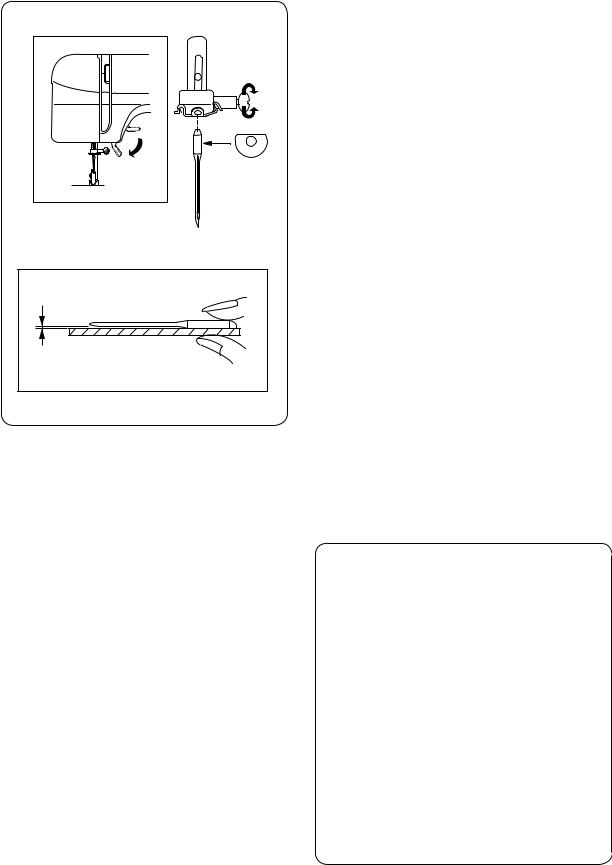Janome JW5622 Instruction Manual

Instruction book

IMPORTANT SAFETY INSTRUCTIONS
When using an electrical appliance, basic safety precautions should always be followed, including the following:
This sewing machine is designed and manufactured for household use only.
Read all instructions before using this sewing machine. DANGER— To reduce the risk of electric shock:
1.An appliance should never be left unattended when plugged in. Always unplug this sewing machine from the electric outlet immediately after using and before cleaning.
2.Always unplug before replacing a sewing machine bulb. Replace bulb with same type rated 15 Watts.
WARNING—To reduce the risk of burns, fire, electric shock, or injury to persons:
1.Do not allow to be used as a toy. Close attention is necessary when this sewing machine is used by or near children.
2.Use this appliance only for its intended use as described in this owner’s manual.
Use only attachments recommended by the manufacturer as contained in this owner’s manual.
3.Never operate this sewing machine if it has a damaged cord or plug, if it is not working properly, if it has been dropped or damaged, or dropped into water.
Return this sewing machine to the nearest authorized dealer or service center for examination, repair, electrical or mechanical adjustment.
4.Never operate the appliance with any air opening blocked. Keep ventilation openings of this sewing machine and foot controller free from accumulation of lint, dust and loose cloth.
5.Never drop or insert any object into any opening.
6.Do not use outdoors.
7.Do not operate where aerosol (spray) products are being used or where oxygen is being administered.
8.To disconnect, turn all controls to the off (“O”) position, then remove plug from outlet.
9.Do not unplug by pulling on cord. To unplug, grasp the plug, not the cord.
10.Keep fingers away from all moving parts. Special care is required around the sewing machine needle and/or cutting blade.
11.Always use the proper needle plate. The wrong plate can cause the needle to break.
12.Do not use bent needles.
13.Do not pull or push fabric while stitching. It may deflect the needle causing it to break.
14.Switch this sewing machine off (“O”) when making any adjustment in the needle area, such as threading the needle, changing the needle, threading the bobbin or changing the presser foot, and the like.
15.Always unplug this sewing machine from the electrical outlet when removing covers, lubricating, or when making any other adjustments mentioned in this owner’s manual.
SAVE THESE INSTRUCTIONS
For Europe only:
This appliance can be used by children aged from 8 years and above and persons with reduced physical, sensory or mental capabilities or lack of experience and knowledge if they have been given supervision or instruction concerning use of the appliance in a safe way and understand the hazards involved. Children shall not play with the appliance. Cleaning and user maintenance shall not be made by children without supervision.
For outside Europe (except U.S.A and Canada):
This appliance is not intended for use by persons (including children) with reduced physical, sensory or mental capabilities, or lack of experience and knowledge, unless they have been given supervision or instruction concerning use of the appliance by a person responsible for their safety.
Children should be supervised to ensure that they do not play with this appliance.
Please note that on disposal, this product must be safely recycled in accordance with relevant National legislation relating to electrical/electronic products. If in doubt please contact your retailer for guidance. (European Union only)
TABLE OF CONTENTS
SECTION I. ESSENTIAL PARTS |
|
Name of Parts...................................................... |
2 |
Extension Table................................................... |
3 |
Free Arm Sewing................................................. |
3 |
Standard Accessories.......................................... |
3 |
Accessories Storage Box..................................... |
3 |
SECTION II. GETTING READY TO SEW |
|
Connecting the Machine to the Power Supply..... |
4 |
Controlling Sewing Speed................................... |
4 |
Presser Foot Lifter............................................... |
5 |
Changing Presser Foot........................................ |
5 |
To Attach and Remove the Foot Holder............... |
5 |
Changing Needles................................................ |
6 |
To check the needle............................................. |
6 |
Thread and Needle Chart.................................... |
6 |
Setting Spool Pins................................................ |
7 |
Removing or Inserting the Bobbin Case.............. |
7 |
Winding the Bobbin.............................................. |
8 |
Threading Bobbin Case....................................... |
8 |
Threading the Machine........................................ |
9 |
Needle Threader.................................................. |
9 |
Drawing Up Bobbin Thread................................ |
10 |
Thread Tension Dial........................................... |
10 |
Stitch Selector Dial............................................. |
11 |
Stitch Length Dial............................................... |
11 |
Stitch Width Dial................................................. |
11 |
Reverse Stitch Button......................................... |
12 |
Darning Plate..................................................... |
12 |
SECTION III. BASIC SEWING |
|
Straight Stitch Sewing........................................ |
13 |
Changing Sewing Direction................................ |
13 |
Seam Guide Lines.............................................. |
14 |
Turning a Square Corner................................... |
14 |
Variable Needle Position.................................... |
14 |
Zigzag Stitching.................................................. |
15 |
Rick-rack Stretch................................................ |
17 |
Sewing Buttons.................................................. |
18 |
Automatic Buttonhole................................... |
19−20 |
Corded Buttonhole............................................. |
21 |
Zipper Application.............................................. |
22 |
Blind Hem Stitch................................................. |
22 |
SECTION V. DECORATIVE STITCHING |
|
Shell Tuck........................................................... |
23 |
Smocking........................................................... |
23 |
Box Stitch........................................................... |
24 |
Applique............................................................. |
24 |
Decorative Stitch................................................ |
25 |
Decorative Satin Stitch Patterns......................... |
25 |
Stretch Stitch Patterns....................................... |
26 |
SECTION VI. MAINTENANCE OF YOUR MACHINE
Cleaning the Bobbin Case and the Hook........... |
26 |
Dismantling Shuttle Race Unit........................... |
26 |
Assembling Shuttle Race Unit........................... |
26 |
Cleaning the Feed Dog...................................... |
27 |
Sewing Light....................................................... |
27 |
Troubleshooting.................................................. |
28 |
SECTION IV. UTILITY STITCHING |
|
Overcasting........................................................ |
15 |
Tricot Stitch......................................................... |
16 |
Knit Stitch........................................................... |
16 |
Straight Stretch.................................................. |
17 |
1

iu
o !0
!1
!2
!3
!4
!5
!7  !8
!8
!9
@0
@1
@2
@3
@4 @5
@9
y t r
 e w
e w
q
!6
@8

 @7
@7
@6
SECTION I. ESSENTIAL PARTS
Name of Parts
q Pattern selector dial w Stitch length dial e Stitch width dial
r Bobbin winder stopper t Bobbin winder spindle y Spool pins
u Bobbin winder thread guide i Thread guide
o Thread take-up lever !0Thread tension dial
!1Face cover !2Thread cutter !3Needle threader !4Needle plate !5Extension table !6Reverse stitch button !7Presser foot holder !8Needle clamp !9Needle
@0Presser foot @1Lever @2Carrying handle @3Handwheel @4Power switch @5Machine socket
@6Free arm @7Buttonhole lever @8Presser foot lifter @9Foot control
NOTE:
To carry the sewing machine, hold the carrying handle with your hand, and support the sewing machine with the other hand.
NOTE:
Sewing machine design and specifications are subject to change without prior notice.
2

Extension Table
The extension table provides added sewing surface and can be easily removed for free arm sewing.
Detaching the table:
Pull the table away from the machine.
Free Arm Sewing
Avoid fabric bunching around the needle when bartacking to reinforce pockets, plackets and waistlines.
For stitching sleeves, waistbands, pant legs or any circular garment area.
For darning socks or mending knees, elbows or areas of wear in children's clothes.
q |
w |
Standard Accessories |
|
q Bobbins |
|||
|
|
||
|
|
w Seam ripper/ Buttonhole opener |
|
|
|
e Needle set |
|
|
|
r Automatic buttonhole foot |
rt Blind hem foot
e |
y Zipper foot |
|
u Darning plate |
t
u
y
Accessories Storage Box
Sewing accessories are conveniently located in the extension table.
q Accessories storage box
q
3

w q e
rt
SECTION II. GETTING READY TO SEW
Connecting the Machine to the Power Supply z Turn off the power switch.
xInsert the machine plug into the machine socket.
c Insert the power supply plug into the outlet.
vTurn on the power switch to turn on the power and sewing light.
q Power supply plug w Power switch
e Outlet
r Machine socket t Machine plug
 CAUTION:
CAUTION:
Before connecting the power cord, make sure the voltage and frequency shown on the machine conform to your electrical power.
NOTE:
While in operation, always keep your eyes on the sewing area, and do not touch any
moving parts such as the thread take-up lever, handwheel or needle.
Always turn off the power switch and unplug from the power supply:
–when leaving the machine unattended.
–when attaching or removing parts.
–when cleaning the machine.
Do not place anything on the foot control, otherwise the machine will run inadvertently.
Controlling Sewing Speed
Sewing speed can be varied by the foot control. The harder you press on the foot control, the faster the machine runs.
 CAUTION:
CAUTION:
Do not place anything on the foot control, otherwise the machine will start advertently.
Operating Instructions
(for the U.S.A and Canada only)
This appliance has a polarized plug (one blade wider than the other). To reduce the risk of an electric shock, this plug is intended to fit in a polarized outlet only one way. If the plug does not fit in the outlet, reverse the plug. If it still does not fit, contact a qualified electrician to install the proper outlet. Do not modify the plug in any way. Foot Controller Model YC-482J-EC or TJC-150 is used with this machine.
4

Presser Foot Lifter
The presser foot lifter raises and lowers your
|
presser foot. |
|
|
You can raise it about 0.6 cm (1/4˝) higher than |
|
|
the normal up position for easy removal of the |
|
e |
presser foot or to help you to place heavy fabric |
|
under the foot. |
||
w |
||
q Lowest position |
||
|
w Normal up position |
|
|
e Highest position |
|
q |
|
Changing Presser Foot
q Lever
w Groove
e Pin
|
|
|
CAUTION: |
|
|
|
When attaching or removing presser foot, turn |
|
|
|
OFF the power switch. |
|
|
|
• To remove |
q |
|
|
Turn the handwheel toward you to raise the |
|
|
needle bar to its highest position. |
|
|
|
|
Raise the presser foot. |
|
|
|
Press the lever q on the back of the foot holder. |
|
|
|
• To attach |
|
|
|
Place the presser foot so that the pin e on the |
w |
|
e |
foot lines up directly below the groove w of the |
|
|
foot holder. Lower the foot holder to lock the foot |
|
|
|
|
|
|
|
|
in place. |
|
|
|
To Attach and Remove the Foot Holder |
|
|
|
q Setscrew |
q |
|
|
w Foot holder |
|
|
|
e Presser bar |
w |
|
|
• To remove |
|
|
Remove the thumb setscrew q by turning it |
|
|
|
|
counterclockwise with a screwdriver. |
|
|
|
e |
|
|
|
• To attach |
|
|
|
Match the hole in the foot holder w with the |
|
q |
|
threaded hole in the presser bar e. Fit the |
|
|
thumb screw q into the hole. Tighten the screw |
|
|
|
|
|
|
|
|
q by turning it clockwise with screwdriver. |
5

Changing Needles
Raise the needle by turning the handwheel toward you and lower the presser foot.
zLoosen the needle clamp screw by turning it counterclockwise.
Remove the needle from the clamp.
xInsert the new needle into the clamp with the flat side away from you.
When inserting the needle into the clamp, push it up as far as it will go and tighten the clamp screw firmly with the screwdriver.
To check the needle
Place the flat side of the needle on something flat (needle plate, glass etc.). The clearance between the needle and flat surface should be consistent. Never use a bent or blunt needle.
Thread and Needle Chart
*In general, fine threads and needles are used for sewing thin fabrics, and thicker threads and needles are used for sewing heavy fabrics.
*Always test thread and needle size on a small piece of the fabric which will be used for actual sewing.
*Use the same thread for needle and bobbin.
*When sewing stretch, very fine fabrics and synthetics,use a BLUE TIPPED needle. The blue tipped needle effectively prevents skipped stitches.
|
Fabrics |
Thread |
Needle Size |
|
|
|
|
|
|
Light |
Crepe de Chine, Voile, |
Fine Silk |
9 |
|
Lawn, Organdy, |
Fine Cotton |
or |
||
weight |
||||
|
Georgette, |
Fine Synthetic |
11 |
|
|
Tricot |
Fine Cotton |
|
|
|
|
Covered |
|
|
|
|
Polyester |
|
|
|
|
|
|
|
Medium |
Linens, Cotton, Piqué, |
50 silk |
11 |
|
weight |
Serge, Double Knits, |
50 to 80 Cotton |
or |
|
|
Percale |
50 to 60 |
14 |
|
|
|
Synthetic |
|
|
|
|
Cotton Covered |
|
|
|
|
Polyester |
|
|
|
|
|
|
|
Heavy |
Denim, Tweed, |
50 silk |
14 |
|
weight |
Gabardine, |
|
or |
|
|
Suiting, Drapery and |
40 to 50 Cotton |
16 |
|
|
Upholstery Fabric |
40 to 50 |
|
|
|
|
Synthetic |
|
|
|
|
Cotton Covered |
|
|
|
|
Polyester |
|
|
|
|
|
|
6

Setting Spool Pins
The spool pins are used for holding the spool of thread in order to feed thread to the machine. To use, pull up the spool pin. Push down for storage.
Removing or Inserting the Bobbin Case
Open the hook cover. q Hook cover
q
Raise the needle by turning the handwheel toward you. Take out the bobbin case by holding the latch.
w Latch
w
|
When inserting the bobbin case, place the horn |
e |
into the recess of the hook race. |
|
e Horn |
7

z |
Winding the Bobbin |
|
z Pull the handwheel out. |
|
x Draw the thread from the spool. |
|
Guide the thread around the bobbin winder |
|
thread guide. |
|
c Insert the thread through the hole in the bobbin |
cfrom the inside to the outside.
Put the bobbin on the bobbin winder spindle.
|
|
v Push it to the right. |
x |
|
b With the free end of the thread held in your |
|
|
hand, depress the foot control. |
|
|
Stop the machine when it has made a few |
|
|
turns, and cut the thread close to the hole in |
|
|
the bobbin. |
b |
|
n Depress the foot control again. |
|
When the bobbin is fully wound, stop the |
|
|
|
|
|
|
machine. |
|
n |
Return the bobbin winder spindle to its original |
|
position by moving the spindle to the left, and |
|
|
|
|
|
|
cut the thread. |
v |
|
m Push the handwheel back into the original |
|
|
position. |
|
m |
NOTE: |
|
|
|
|
|
Return the bobbin winder spindle to the left |
|
|
when the bobbin winding is finished. |
Threading Bobbin Case
z
z Place the bobbin into the bobbin case.
Make sure the thread unwinds in the direction of arrow.
x |
x Pull the thread into the bobbin case slot. |
c |
c Draw the thread under the tension spring and |
into the delivery eye.
* Leave about 10 cm (4˝) of free thread.
8
